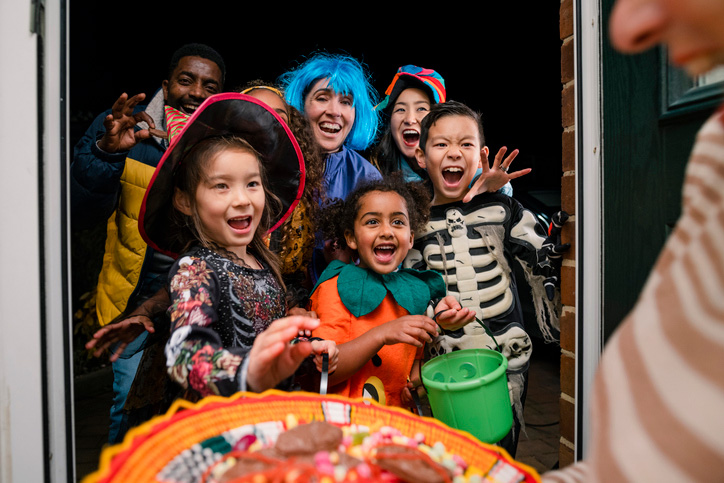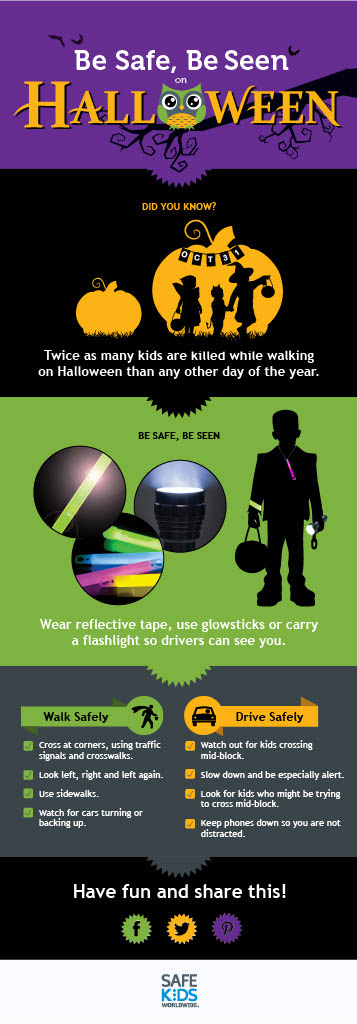Tips for a Safe Halloween
10.17.2024 | Heather Cooper

Boo! Halloween is on a school night again this year, making it trickier to get in all of the treat-gathering fun. However, you can maximize your family’s enjoyment by planning ahead. Dr. Tony Woodward, chief of Emergency Medicine at Seattle Children’s, offers tips for how to safely celebrate what many kids consider to be the best holiday of the year.
“Halloween is a holiday that kids look forward to for weeks or even months in advance,” said Woodward. “I encourage families to think about safety as they start selecting costumes and making plans to celebrate with others. Taking steps before the big night, like agreeing on ground rules and ensuring costumes will be seen in the dark, provides more time to safely enjoy Halloween.”
Before Halloween
A staple decoration for the Halloween season is the jack-o-lantern, the decoration that can cause carving accidents. It’s best to have young children draw a face on the pumpkin and leave the carving to an adult, letting the child scoop out the insides with a spoon. Consider purchasing a pumpkin carving kit that comes with a small, serrated saw that’s easier to control and less apt to cause serious injury. Work in a well-lit area and be sure the outside of the pumpkin, your hands and the tool you’re using are all dry. Before allowing tweens and teens to carve, show them safe techniques, like cutting away from the body and using small, controlled strokes. Supervise closely when it’s their turn to carve.
When selecting costumes, avoid masks as they make it hard to see and breathe. Non-toxic makeup is better, but it’s wise to test it on a small patch of skin before Halloween to be sure there’s no skin reaction. Choose flame-resistant materials and be sure costumes aren’t too long, to help prevent trips and falls, the most common type of Halloween injuries. Light-colored fabrics or costumes with reflective tape help children to be seen. Add reflective tape or purchase a couple of glow sticks or glow bracelets or necklaces to attach to dark costumes.
When it comes to accessories, don’t be tempted by costume contact lenses – they can cause serious eye damage. When adding a prop, like a sword, choose a soft and short one to avoid injury should your child fall on it or joust with their friends. Top the costume off with sensible shoes to prevent trips and falls.
Purchase store-bought food items or non-food treats rather than planning to hand out home-baked items.
“Consider offering only non-food treats or a choice between standard treats and non-food treats,” said Woodward. “Families of children with food allergies especially appreciate being offered a choice.”
If your child enjoys trick-or-treating with others, start making those plans now, giving you time to be thoughtful about agreements you make. You’ll want to be clear on how long your child can be out, especially considering it’s a school night. Getting on the same page with other families you’re celebrating with is important. If your child is under 12, they should have an adult with them while trick-or-treating. Clarifying this rule ahead of time can prevent a disagreement on the holiday.
Halloween night
Provide a healthy meal before the trick-or-treating fun begins. This will help prevent kids from being too hungry and gorging themselves with candy during the evening. Use the mealtime to reconfirm where older kids are headed, who they’ll be with and when they’ll be home. Remind them to be polite when receiving candy and careful of younger trick-or-treaters they’ll encounter.
For kids of all ages, give reminders for how to be a safe pedestrian:
- Carry a flashlight or glow stick to help ensure you can be seen.
- Cross only at corners and never between parked vehicles.
- Look both ways before crossing, and continue to look both ways as you walk, not run, across the street.
- Only use your phone for its flashlight function while walking; your attention needs to be on where you’re walking, especially while near traffic.
- Walk on the sidewalk or path. When there isn’t one, walk single-file, as far to the left as possible, facing traffic.
- Be alert when walking past alleys and driveways where vehicles can be pulling in or out.
“Unfortunately, children are more likely to be hit by a vehicle and injured on Halloween than on any other day of the year,” said Woodward. “It’s vital to take a few minutes to reinforce how to be a safe pedestrian if your child is headed out with friends, and even if you’ll be accompanying them.”
Prepare your home if you’ll be greeting trick-or-treaters. Check for tripping hazards in your yard and near your front door. Light the way, but avoid using candles. Keep your dog away from trick-or-treaters.
If Halloween plans find you needing to drive, use extra caution. Be alert and drive slowly in neighborhoods. Do not be distracted while driving and be extra careful when pulling out from alleys and driveways.
Look at your child’s candy before letting them eat it and throw away items that are partially open or look unsafe. Agree on how much candy they can eat that night and, in the days ahead. Consider keeping the candy for them, rather than in plain sight or in their bedroom. Think about buying some back from your child or giving some away.
Finally, try to get some good sleep before the alarm signals the arrival of morning!
Resources
- ‘Colored’ and Decorative Contact Lenses: A Prescription Is A Must
- Teal Pumpkin Project from Food Allergy Research & Education
- Making Halloween Fun for Everyone, Autism Speaks
